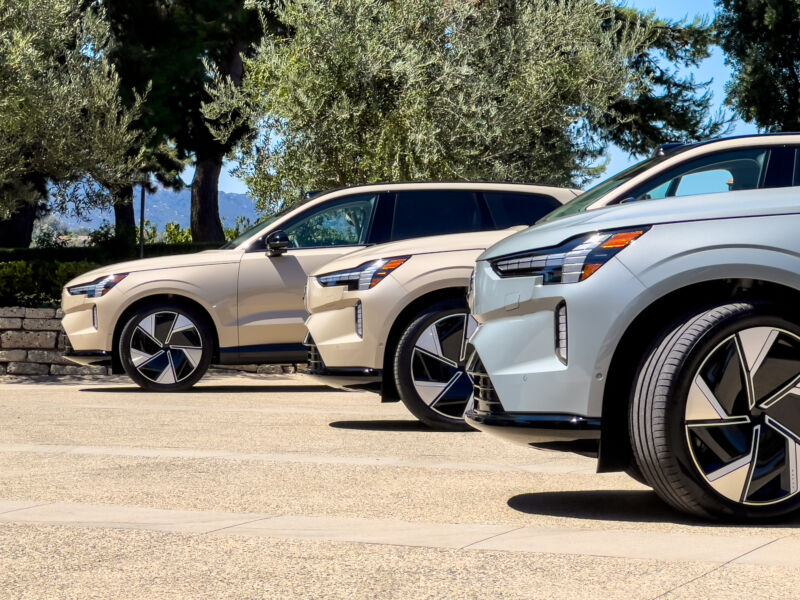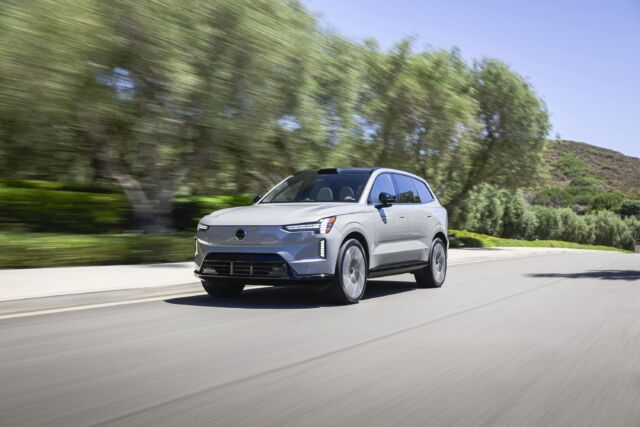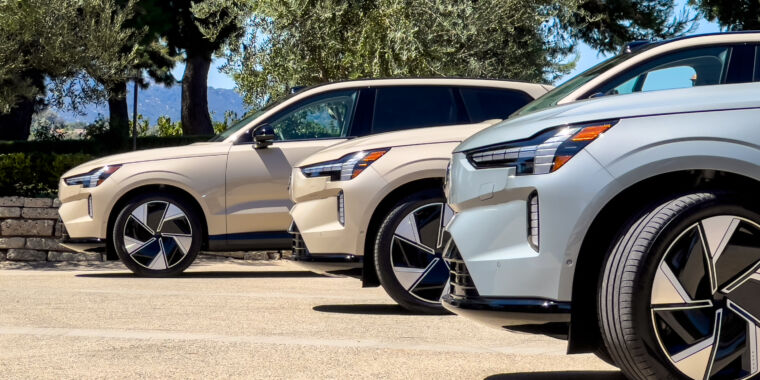
Jonathan Gitlin
Volvo, an early convert to the idea of a fully electrified lineup, has taken a slightly different approach than most other automakers in electrifying its product lineup. Where most would start with a large, expensive electric vehicle, it did the opposite, starting with a small, affordable vehicle. That means it’s now time for a flagship EV, an all-new three-row SUV called the EX90, which we’ve been driving ahead of U.S. deliveries toward the end of this year.
That’s later than Volvo had planned, and as you’ll see, some EX90 features have fallen even further behind and will need to be enabled via a future software update. Because while the EX90 is a great demonstration of a new, technologically advanced approach to car design, it’s also the latest example of automakers adopting the tech industry’s “minimal viable product” approach.
Volvo has developed an all-new platform for larger EVs, which the EX90 will share with other brands within the Geely group, most notably the Polestar 3 that we drove a few weeks ago . The Volvo is a bit longer than the Polestar, and unlike the fledgling startup’s SUV, the EX90 is a three-row car with seating for either six or seven, depending on whether you opt for a bench or a pair of captain’s chairs for the middle row.

James Lipman/Volvo
The good
The SUV has a handsome, well-proportioned shape with some subtly raked corners, particularly around the rear wheels, though the roof-mounted lidar unit has prompted comparisons to a London taxi , and some of the test cars felt a little too at home in the arid Southern California landscape thanks to their beige paintwork. As we’ve come to expect from Volvo, there’s a wealth of interesting design details inside and out, with plenty of storage spaces, bag hooks, cupholders and USB-C ports.
Two powertrain options are available for the EX90 for now, a $79,995 Twin Motor version with a combined output of 402 hp (300 kW) and 568 lb-ft (770 Nm) or the $84,995 Twin Motor Performance, which ups output to 509 hp (380 kW) and 671 lb-ft (910 Nm). In either case, the rear electric motor is more powerful, with clutch-based torque vectoring that also allows the rear drive unit to fully disengage the rear wheels for improved coasting.
Both variants use the same 111 kWh capacity (gross, 107 kW usable) battery pack, enough for 310 miles (499 km) of range according to the EPA test cycle. Charging the pack takes just 30 minutes to go from 10 to 80 percent state of charge with a DC fast charger (peak at 250 kW), or 15 hours to go from 0 to 100 percent SoC with a 32 A level 2 charger.
Volvo brought only the EX90 Twin Motor Performance to Newport Coast to drive, and the cars were equipped with the $4,350 Ultra package, which adds active air suspension and massaging seats, as well as wireless phone charging. The standard Plus package comes very well equipped, but we needed to put some miles in it to see what effect the standard coil springs and hydraulic dampers have on the ride.
-
The design is not revolutionary, but it is beautiful.
Volvo
-
There are two IR cameras that track the driver's gaze: one in the steering column and the other at the base of the speaker in the center of the dashboard.
James Lipman/Volvo
-
The infotainment has a new UI. There’s a fixed row of icons at the bottom, then a row of contextual icons, then space for two user-defined widgets, with the map in the top two-thirds.
James Lipman/Volvo
-
The middle row is a bench as standard.
James Lipman/Volvo
-
There is little legroom in the third row.
James Lipman/Volvo
-
Volvo gets more adventurous with its taillights.
James Lipman/Volvo
-
As with all SUVs with three rows of seats, you can choose between passengers or luggage.
James Lipman/Volvo
-
Volvo, unlike some other OEMs, is brave enough to bring a wool interior to North America. Synthetic leather is an option, but we'd go with wool.
James Lipman/Volvo
-
Mirrors for people, cameras for the car.
Jonathan Gitlin
-
There is a frunk, but it's not that big.
Jonathan Gitlin
-
If you choose the Captain seats, they are equipped with cup holders in the armrests.
Jonathan Gitlin
The adaptive air springs did much to disguise this SUV’s hefty 5,688-lb (2,580-kg) curb weight. And the ride quality was remarkably good, particularly at highway speeds. The downside was less-than-stellar body control over low-speed obstacles like potholes, construction zones, and the like; lateral movement could be better controlled to keep the seat bolsters from doing percussive maintenance to your kidneys. You can also feel the torque vectoring at work, particularly in slow-speed corners, which lends this big SUV a bit of extra agility.

